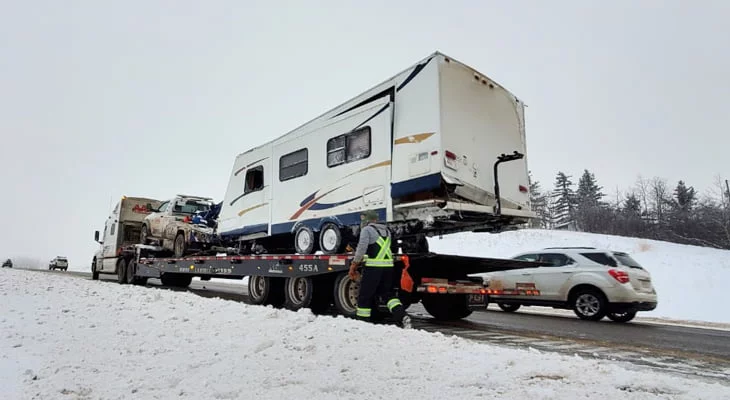Post Preview
Table of Contents
- Key Takeaways
- Understanding the Terms: Watch vs. Warning
- The Significance of Timing
- Preparing for a Hurricane Watch
- Responding to a Hurricane Warning
- The Role of Technology in Hurricane Preparedness
- Community Preparedness
- Conclusion
Key Takeaways
- It is essential to distinguish between a hurricane watch and a warning to respond quickly and efficiently.
- Preparation should begin as soon as a hurricane watch is issued, and more urgent measures should be taken when a warning is declared.
- Technological tools and community resources are invaluable in hurricane preparedness and response.
- Personal and community preparedness can significantly reduce the impact of hurricanes.
Understanding the Terms: Watch vs. Warning
A fundamental aspect of hurricane preparedness is understanding the terminology meteorologists and emergency services use. “hurricane watch” and “hurricane warning” are often used. Still, they signify different threat levels and required actions. It is crucial to differentiate between these terms to respond appropriately to an impending hurricane.
A hurricane watch versus warning involves different levels of alert. A hurricane watch means hurricane conditions (sustained winds of 74 mph or higher) are possible within a specified area. These are typically issued 48 hours before the anticipated onset of tropical storm-force winds. In contrast, a hurricane warning is issued when hurricane conditions are expected within 36 hours. It signifies an imminent threat and immediate action should be taken to protect life and property.
The Significance of Timing
The timing of a watch or warning is critical in hurricane preparedness. The advance notice a watch provides allows individuals and communities to take preliminary steps to safeguard their homes and prepare for a potential evacuation. Activities during this phase include securing outdoor furniture, stocking up on essential supplies, and ensuring that emergency kits are ready.
When a warning is issued, the timeframe to act is significantly shorter. Immediate measures, such as boarding up windows, moving to a safer location, and completing evacuation plans, need to be executed without delay. The urgency highlighted by a hurricane warning emphasizes the importance of having pre-planned strategies that can be deployed quickly.
Preparing for a Hurricane Watch
When a hurricane watch is announced, it signals to start implementing your preparedness plans. At this stage, you should:
1. Stay Informed: Regularly monitor weather updates from trusted meteorological sources and local news channels. Understanding the storm’s projected path and intensity will help you make informed decisions.
2. Assemble Emergency Kits: Ensure your emergency kit is comprehensive and accessible. Include items like non-perishable food, water, flashlights, batteries, first aid supplies, medications, and essential documents.
3. Protect Your Property: Begin securing your property by taking measures such as trimming trees, bringing inside any objects that could become projectiles, and reinforcing doors and windows.
4. Backup Important Data: Make digital backups of important documents and store them in a secure location. This can include copies of identification, insurance policies, medical records, and financial documents.
5. Plan for Pets: Ensure you have pet provisions, including food, water, and any necessary medications. Identify pet-friendly shelters or make arrangements with friends or family if evacuation becomes necessary.
Responding to a Hurricane Warning
When a hurricane warning is issued, it indicates that hurricane conditions are imminent. Immediate and decisive actions are required to ensure your safety and that of your loved ones. Key actions to take include:
1. Finalize Your Preparations: Complete any remaining tasks to secure your property, such as boarding up windows and reinforcing garage doors. If you are in a flood-prone area, move valuables to higher ground.
2. Evacuate if Ordered: Follow evacuation orders issued by local authorities promptly. Evacuation zones are designated for a reason, and staying behind can put you and first responders at risk.
3. Communicate Your Plans: Inform family members and friends about your evacuation plans and establish a point of contact. Ensure everyone knows how to stay in touch during the hurricane.
4. Seek Shelter: If you are not in an evacuation zone, identify the safest part of your home, typically an interior room with no windows. Ensure you have supplies to sustain you for at least 72 hours.
5. Stay Indoors: Remain indoors and away from windows during the storm. The most vital part of the hurricane typically causes the most damage, so staying protected is crucial until authorities declare it safe to leave your shelter.
The Role of Technology in Hurricane Preparedness
Technology plays a pivotal role in hurricane preparedness and response. Modern advancements provide tools and resources that significantly enhance your ability to stay safe and informed. Some useful technologies include:
1. Weather Apps: Many weather apps provide real-time updates on storm paths, intensity, and anticipated arrival times. Alerts and notifications can keep you informed about changing conditions.
2. Social Media: Platforms like Twitter and Facebook can provide up-to-the-minute updates from meteorologists, emergency services, and government agencies. Follow reputable sources and enable notifications to stay informed.
3. Emergency Alert Systems: Local authorities often use emergency alert systems to communicate important information. These systems can send alerts via text, email, or phone calls directly to your devices.
4. Smart Home Devices: Smart home technology, such as security cameras and weather monitoring systems, can provide valuable information and help you monitor conditions in and around your home.
5. Online Communities: Participating in online forums and community groups dedicated to hurricane preparedness can provide valuable tips, resources, and support from others who have experienced similar situations.
Community Preparedness
Community preparedness is essential in mitigating the impact of hurricanes. Strong community ties and collaborative efforts can enhance overall resilience and recovery. Critical components of community preparedness include:
1. Public Education: Communities should engage in public education campaigns to raise awareness about hurricane risks and preparedness strategies. Schools, community centers, and local organizations can be vital in disseminating information.
2. Emergency Services Coordination: Coordination among emergency services, including police, fire departments, and medical services, is crucial for an effective response. Regular drills and inter-agency communication can enhance preparedness.
3. Community Emergency Response Teams (CERT): CERT programs train volunteers in basic disaster response skills. These teams can assist with evacuation efforts, provide first aid, and support affected community members.
4. Resources and Shelter: Communities should have designated shelters and resources to support residents during a hurricane. This includes providing food, water, medical supplies, and safe evacuation locations.
5. Post-Disaster Support: Recovery efforts are essential for rebuilding and restoring community stability. Establishing recovery plans, offering mental health support, and facilitating access to financial assistance can aid in the healing process.
Conclusion
Understanding and effectively responding to hurricane watches and warnings are critical to staying safe and prepared during hurricane season. By recognizing the differences between a hurricane watch and a warning, taking timely and appropriate actions, leveraging technology, and fostering community preparedness, individuals and communities can reduce the devastating impacts of hurricanes.
Preparation begins long before a storm is on the horizon, and it involves continuous efforts to ensure safety and resilience. Personal preparedness plans and strong community efforts can significantly affect how well individuals and communities withstand and recover from hurricanes. Stay informed, stay prepared, and prioritize safety above all else.






Be First to Comment